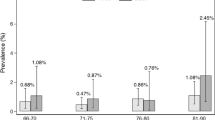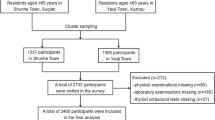Abstract
Thyroid hormones, including free triiodothyronine (FT3), free thyroxine (FT4), have well-recognized effects on the cardiovascular system. However, the evidence is lacking regarding the relationship between repeated FT3, FT4, and thyroid-stimulating hormone (TSH) measurements and incident hypertension. The aim of this cohort study was to examine how longitudinal trends of serum FT3, FT4, and TSH levels are related to the development of hypertension in a euthyroid population. A prospective study (n = 5926) was performed in Tianjin, China. Participants without a history of hypertension were followed up for ~4 years (median: 3 years). Hypertension was defined according to the criteria of JNC7. FT3, FT4, and TSH were determined by chemiluminescence immunoassay methods. FT3, FT4, TSH, and blood pressure were assessed yearly during follow-up. Adjusted Cox proportional hazards regression models were used to assess the relationships between baseline, means, and annual changes in FT3, FT4, TSH, and hypertension. The incidence rate of hypertension per 1000 person-years was 73. Compared with the lowest quartile, the multivariable-adjusted hazards ratios (95% confidence interval) for hypertension in the highest quartiles of changes in FT3, FT4, and TSH were 1.51 (1.23–1.84), 2.04 (1.67–2.48), and 1.20 (0.99–1.45), respectively. Similar relationships were observed between the means of FT3, FT4, TSH, and hypertension. However, we found no correlations between baseline FT3, FT4, TSH, and incident hypertension. The present study is the first to demonstrate that the annual changes and means, but not baseline FT3 and FT4 values are independently related to the risk of incident hypertension in the euthyroid general population.
This is a preview of subscription content, access via your institution
Access options
Subscribe to this journal
Receive 12 digital issues and online access to articles
$119.00 per year
only $9.92 per issue
Buy this article
- Purchase on Springer Link
- Instant access to full article PDF
Prices may be subject to local taxes which are calculated during checkout

Similar content being viewed by others
Code availability
Data cannot be made publicly available because public availability would compromise participant privacy. For data access, researchers can contact the Nutritional Epidemiology Institute and School of Public Health, Tianjin Medical University, Tianjin, China (E-mail address: nkj0809@gmail.com or niukaijun@tmu.edu.cn).
References
Bromfield S, Muntner P. High blood pressure: the leading global burden of disease risk factor and the need for worldwide prevention programs. Curr Hypertens Rep. 2013;15:134–6.
Collaboration NCDRF. Worldwide trends in blood pressure from 1975 to 2015: a pooled analysis of 1479 population-based measurement studies with 19.1 million participants. Lancet. 2017;389:37–55.
Kearney PM, Whelton M, Reynolds K, Muntner P, Whelton PK, He J. Global burden of hypertension: analysis of worldwide data. Lancet. 2005;365:217–23.
Wang Z, Chen Z, Zhang L, Wang X, Hao G, Zhang Z, et al. Status of hypertension in China: results from the China hypertension survey, 2012–2015. Circulation. 2018;137:2344–56.
Klein I, Danzi S. Thyroid disease and the heart. Circulation. 2007;116:1725–35.
Klein I, Ojamaa K. Thyroid hormone and the cardiovascular system. N. Engl J Med. 2001;344:501–9.
Obuobie K, Smith J, Evans LM, John R, Davies JS, Lazarus JH. Increased central arterial stiffness in hypothyroidism. J Clin Endocrinol Metab. 2002;87:4662–6.
Napoli R, Biondi B, Guardasole V, Matarazzo M, Pardo F, Angelini V, et al. Impact of hyperthyroidism and its correction on vascular reactivity in humans. Circulation. 2001;104:3076–80.
Biondi B, Palmieri EA, Lombardi G, Fazio S. Effects of thyroid hormone on cardiac function: the relative importance of heart rate, loading conditions, and myocardial contractility in the regulation of cardiac performance in human hyperthyroidism. J Clin Endocrinol Metab. 2002;87:968–74.
Mancia G, Fagard R, Narkiewicz K, Redon J, Zanchetti A, Bohm M, et al. 2013 ESH/ESC Guidelines for the management of arterial hypertension: the Task Force for the management of arterial hypertension of the European Society of Hypertension (ESH) and of the European Society of Cardiology (ESC). J Hypertens. 2013;31:1281–357.
Kwon BJ, Roh JW, Lee SH, Lim SM, Park CS, Kim DB, et al. A high normal thyroid-stimulating hormone is associated with arterial stiffness, central systolic blood pressure, and 24-hour systolic blood pressure in males with treatment-naive hypertension and euthyroid. Int J Cardiol. 2014;177:949–56.
Iqbal A, Figenschau Y, Jorde R. Blood pressure in relation to serum thyrotropin: the Tromso study. J Hum Hypertens. 2006;20:932–6.
Asvold BO, Bjoro T, Nilsen TI, Vatten LJ. Association between blood pressure and serum thyroid-stimulating hormone concentration within the reference range: a population-based study. J Clin Endocrinol Metab. 2007;92:841–5.
Amouzegar A, Heidari M, Gharibzadeh S, Mehran L, Tohidi M, Azizi F. The association between blood pressure and normal range thyroid function tests in a population based Tehran thyroid study. Horm Metab Res. 2016;48:151–6.
He W, Li S, Wang B, Mu K, Shao X, Yao Q, et al. Dose-response relationship between thyroid stimulating hormone and hypertension risk in euthyroid individuals. J Hypertens. 2019;37:144–53.
Langen VL, Niiranen TJ, Puukka P, Sundvall J, Jula AM. Association between thyroid-stimulating hormone and blood pressure in adults: an 11-year longitudinal study. Clin Endocrinol. 2016;84:741–7.
Ittermann T, Tiller D, Meisinger C, Agger C, Nauck M, Rettig R, et al. High serum thyrotropin levels are associated with current but not with incident hypertension. Thyroid. 2013;23:955–63.
Abdi H, Gharibzadeh S, Tasdighi E, Amouzegar A, Mehran L, Tohidi M, et al. Associations between thyroid and blood pressure in euthyroid adults: a 9-year longitudinal study. Horm Metab Res. 2018;50:236–41.
Meyerovitch J, Rotman-Pikielny P, Sherf M, Battat E, Levy Y, Surks MI. Serum thyrotropin measurements in the community: five-year follow-up in a large network of primary care physicians. Arch Intern Med. 2007;167:1533–8.
Diez JJ, Iglesias P, Burman KD. Spontaneous normalization of thyrotropin concentrations in patients with subclinical hypothyroidism. J Clin Endocrinol Metab. 2005;90:4124–7.
Garber JR, Cobin RH, Gharib H, Hennessey JV, Klein I, Mechanick JI, et al. Clinical practice guidelines for hypothyroidism in adults: cosponsored by the American Association of Clinical Endocrinologists and the American Thyroid Association. Endocr Pr. 2012;18:988–1028.
Rugge B, Balshem H, Sehgal R, Relevo R, Gorman P, Helfand M. Screening and treatment of subclinical hypothyroidism or hyperthyroidism: Rockville (MD); Agency for Healthcare Research and Quality (US), 2011.
UK Guidelines for the Use of Thyroid Function Tests British Thyroid Association. http://www.btf-thyroid.org/images/documents/tft_guideline_final_version_july_2006.pdf. Accessed March 2019. 2006.
Gu Y, Li H, Bao X, Zhang Q, Liu L, Meng G, et al. The relationship between thyroid function and the prevalence of type 2 diabetes mellitus in euthyroid subjects. J Clin Endocrinol Metab. 2017;102:434–42.
Gu Y, Wang Y, Zhang Q, Liu L, Meng G, Yao Z, et al. The association between thyroid function and incidence of metabolic syndrome in euthyroid subjects: Tianjin chronic low-grade systemic inflammation and health cohort study. Clin Endocrinol. 2018;88:735–43.
Gu Y, Zheng L, Zhang Q, Liu L, Meng G, Yao Z, et al. Relationship between thyroid function and elevated blood pressure in euthyroid adults. J Clin Hypertens. 2018;20:1541–9.
Kobalava ZD, Kotovskaya YV, Babaeva LA, Moiseev VS. Validation of TM-2655 oscillometric device for blood pressure measurement. Blood Press Monit. 2006;11:87–90.
Chobanian AV, Bakris GL, Black HR, Cushman WC, Green LA, Izzo JL Jr., et al. The seventh report of the joint national committee on prevention, detection, evaluation, and treatment of high blood pressure: the JNC 7 report. JAMA. 2003;289:2560–72.
Horowitz GL, Altaie S, Boyd JC. Defining, establishing and verifying reference intervals in the clinical laboratory; aproved guideline-third edition. 2010. CLSI Document EP28-A3c.
Porcu E, Medici M, Pistis G, Volpato CB, Wilson SG, Cappola AR, et al. A meta-analysis of thyroid-related traits reveals novel loci and gender-specific differences in the regulation of thyroid function. PLoS Genet. 2013;9:e1003266.
Alberti KG, Eckel RH, Grundy SM, Zimmet PZ, Cleeman JI, Donato KA, et al. Harmonizing the metabolic syndrome: a joint interim statement of the International Diabetes Federation Task Force on Epidemiology and Prevention; National Heart, Lung, and Blood Institute; American Heart Association; World Heart Federation; International Atherosclerosis Society; and International Association for the Study of Obesity. Circulation. 2009;120:1640–5.
Davies PH, Franklyn JA. The effects of drugs on tests of thyroid function. Eur J Clin Pharm. 1991;40:439–51.
Hamed SA. The effect of antiepileptic drugs on thyroid hormonal function: causes and implications. Expert Rev Clin Pharm. 2015;8:741–50.
Liang Y, Liu R, Du S, Qiu C. Trends in incidence of hypertension in Chinese adults, 1991–2009: the China Health and Nutrition Survey. Int J Cardiol. 2014;175:96–101.
Qi SF, Zhang B, Wang HJ, Yan J, Du P, Zhang W, et al. Joint effects of age and body mass index on the incidence of hypertension subtypes in the China Health and Nutrition Survey: A cohort study over 22years. Prev Med. 2016;89:23–30.
WHO. A global brief on hypertension. Geneva: World Health Organization. 2013. http://apps.who.int/iris/bitstream/10665/79059/1/WHO_DCO_WHD_2013.2_eng.pdf. Accessed 3 Sep 2016.
Asvold BO, Bjoro T, Vatten LJ. Associations of TSH levels within the reference range with future blood pressure and lipid concentrations: 11-year follow-up of the HUNT study. Eur J Endocrinol. 2013;169:73–82.
Mariotti S, Franceschi C, Cossarizza A, Pinchera A. The aging thyroid. Endocr Rev. 1995;16:686–715.
Polikar R, Burger AG, Scherrer U, Nicod P. The thyroid and the heart. Circulation. 1993;87:1435–41.
DiBona GF. Sympathetic nervous system and hypertension. Hypertension. 2013;61:556–60.
Laragh JH, Sealey JE. Relevance of the plasma renin hormonal control system that regulates blood pressure and sodium balance for correctly treating hypertension and for evaluating ALLHAT. Am J Hypertens. 2003;16:407–15.
Danzi S, Klein I. Thyroid hormone and the cardiovascular system. Minerva Endocrinol. 2004;29:139–50.
Gumieniak O, Perlstein TS, Hopkins PN, Brown NJ, Murphey LJ, Jeunemaitre X, et al. Thyroid function and blood pressure homeostasis in euthyroid subjects. J Clin Endocrinol Metab. 2004;89:3455–61.
Tohidi M, Baghbani-Oskouei A, Amouzegar A, Mehran L, Azizi F, Hadaegh F. Serum thyroid peroxidase antibody level and incident hypertension in iranian men: a suggestion for the role of thyroid autoimmunity. Endocr Metab Immune Disord Drug Targets. 2020;20:1711–8.
Acknowledgements
The authors gratefully acknowledge Huiping Li, Jun Dong, Xiaoxi Zheng, Shinan Gan, Tong Ji, Jie Cheng, Mingxu Ye, Zhixia Cao, Xu Zhang and Xinrong Dong that have made this study.
Funding
This work was supported by grants from the National Natural Science Foundation of China (No. 91746205, 81872611, and 81673166), China.
Author information
Authors and Affiliations
Corresponding authors
Ethics declarations
Conflict of interest
The authors declare that they have no conflict of interest.
Additional information
Publisher’s note Springer Nature remains neutral with regard to jurisdictional claims in published maps and institutional affiliations.
Rights and permissions
About this article
Cite this article
Wang, Y., Gu, Y., Zhang, Q. et al. The association between longitudinal trends of thyroid hormones levels and incident hypertension in a euthyroid population. J Hum Hypertens 35, 1159–1169 (2021). https://doi.org/10.1038/s41371-020-00474-4
Received:
Revised:
Accepted:
Published:
Issue Date:
DOI: https://doi.org/10.1038/s41371-020-00474-4



